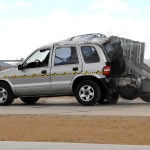Fuel Tank Fill Pipe Valve Prevents Leakage in Crash
- cases-drops0c
- Nov 14, 2023
- 2 min read
September 22, 2009 by markarndt
A recent crash test conducted by the San Francisco Law Firm Lieff Cabraser Heimann & Bernstein (under the direction of Transportation Safety Technologies, Inc.) has provided an important measure of the feasibility and performance of fuel tank fill pipe valves in crash situations when the fill pipe is severed or damaged.
The valve positioned inside the fuel tank at the end of the fuel tank fill pipe was part of the Onboard Refueling Vapor Recovery (ORVR) system. ORVR was a safety feature first dictated for passenger cars in 1998 by the US Environmental Protection Agency (EPA) to limit fuel emissions. The ORVR required that fuel vapor generated during vehicle refueling be stored on the vehicle instead of at the gas station. Stored refueling vapors are burned in the vehicle engine after refueling.
A common feature of ORVR systems are mechanism that minimize fuel atomization as it enters the fuel tank and limits to migration of vapors out of the tank when the fuel cap is off. Most manufactures utilize a one way valve on the fuel tank fill pipe. The valve is located either in the fuel tank or in-line of the fill pipe. Some vehicle manufactures have utilized valves that serve a dual purpose of vapor barrier for ORVR and liquid fuel barrier for crashworthiness. The dual purpose valve is a preferred and logical choice given the vulnerability of some fuel tank fill pipes and fuel caps in crashed. Sport Utility Vehicles with their high rates of rollovers are natural benefactors of valves that prevent spilled gasoline from fuel tank fill pipes.
The crash test involved a 2001 Kia Sportage with a modified rear suspension and fuel tank shield. The vehicle was stuck by a Federal Motor Vehicle Safety Standard 214/311R (FMVSS214/301R) moving deformable barrier ballasted to 5011 pounds. The Sportage fuel tank was filled to 15.4 gallons which is about 92 percent of its refill capacity. The Sportage was hit squarely at the rear with the left edge of the barrier aligned 16.5 inches to the right of the Sportage centerline – a right offset rear impact.
As a result of the crash the modified rear suspension posed no threat of puncture to the fuel tank and the fuel tank shield worked. There were no punctures of the fuel tank, but there was a separation of the fuel tank fill pipe. A reinforced rubber interconnecting fill pipe hose tore apart in the crash. The fill pipe failure was observable only as the fuel tank was removed. A static rollover conducted after the crash test pursuant to the rollover test requirement s of FMVSS301 demonstrated no fuel leakage from any portion of the fuel tank – proof that the one way flow valve in the fuel tank fill pipe worked.




Comments